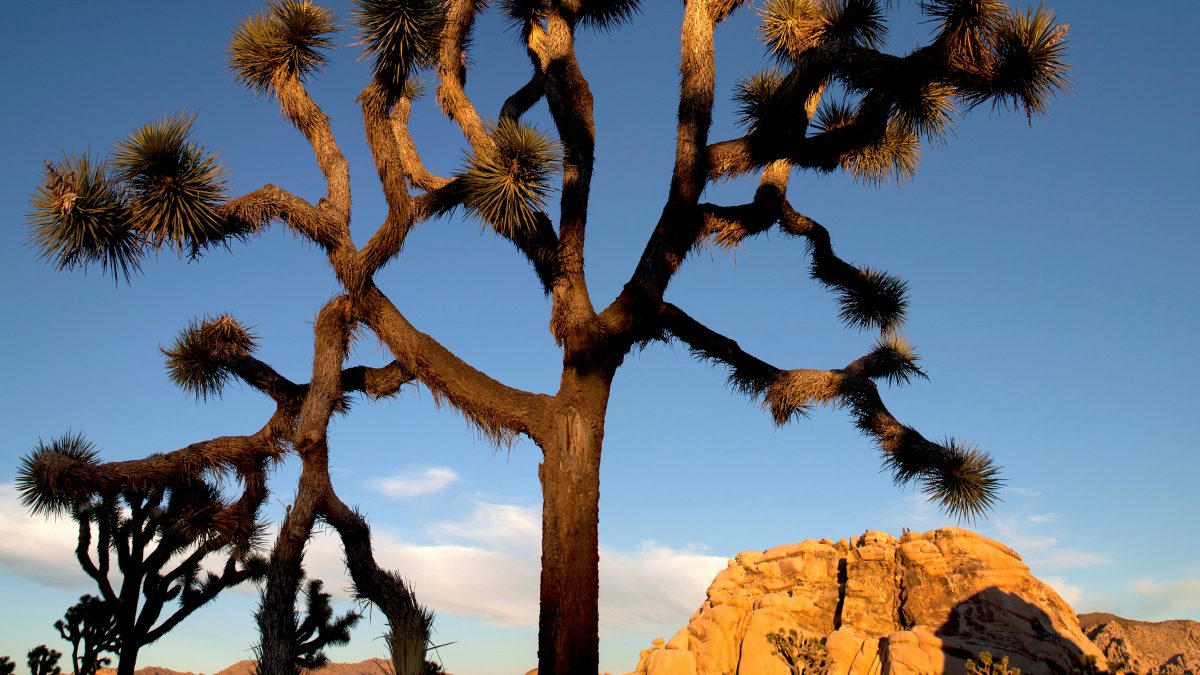The following list is designed for a non-guided backpacking trip in Joshua Tree National Park. (For information about visiting the park, see our Joshua Tree Visitor’s Guide.) The list includes some environment-specific options for the park’s desert backcountry. If you’re going with a commercial group, check with the guide company to see what items it provides.
Included in this list are the Ten Essential Systems you should have on every backcountry trip: navigation; sun protection; insulation; illumination; first-aid supplies; fire starter; repair kit and tools; nutrition; hydration; emergency shelter. To learn more, see our Ten Essentials article.
Printer-friendly version (PDF)
Equipment
Important info about water: Because all water sources in the park are reserved for wildlife, you have to bring all the water you’ll need for your backcountry trip. The park service recommends 1–2 gallons per day, depending on the temperature and your activity level. That’s just for drinking. For hygiene and cooking, you’ll need more.
The backpacking pack you choose will need to have enough space for your whole water supply. An alternative is caching. The park service allows multi-day hikers to cache food and water for up to 14 days.
- Backpacking Pack (70+L) and raincover
- Small daypack (optional)
- Tent with guylines and repair sleeve
- Tent footprint (optional)
- Sleeping bag (look at warmer bags for fall through spring hikes)
- Waterproof stuff sack for your sleeping bag
- Sleeping pad
- Whistle (plus signaling mirror)
- Multifunction watch with altimeter (altimeter feature is optional)
- Knife or multi-tool
- Compass
- GPS (optional)
- Topo Map(s) and route description or guidebook
- Trekking poles (optional)
- LED headlamp with extra batteries
- Water treatment system (for treating natural water source in an emergency)
- Stove, fuel and repair kit (no fires are allowed in backcountry)
- Matches or lighter
- Cookset, dishes, bowls, utensils, cups (measuring/drinking)
- Repair kits for sleeping pad and other gear; duct tape strips
- Fire starter (for emergency survival fire)
Clothing and Footwear
In Joshua Tree’s desert environment, sun protection is essential. Wear loose-fitting, light-colored clothing and a wide-brimmed hat. Apply sunscreen to all exposed skin. Some trails can be overgrown, so long or convertible pants are best to avoid scratches and protect against cactus spines. Because the temperature in the park can change as much as 40 degrees in 24 hours, you should bring plenty of layers.
- Wicking, quick-drying underwear
- Wicking, quick-drying sports bra
- Wicking, quick-drying long underwear
- Wicking, quick-drying T-shirt and long-sleeve shirt
- Convertible, quick-drying, lightweight pants
- Quick-drying, lightweight shorts
- Fleece jacket or vest, or insulated jacket or vest (depending on season)
- Fleece pants (optional)
- Waterproof/breathable rain jacket
- Waterproof/breathable rain pants
- Bandana or Buff
- Sun-shielding hat or ball cap
- Winter hat (depending on season)
- Warm gloves or mittens (in colder months)
- Leather gloves (for scrambling over the park’s rough monzogranite rocks)
- Hiking boots or shoes suited to terrain (light, breathable)
- Socks (synthetic or wool) plus spares
- Gaiters (low)
- Sandals (for relaxing in camp)
Personal Items
- Sunglasses
- Water bottles or hydration reservoirs (enough to carry 1–2 gallons for each day)
- Sunscreen
- Lip balm (SPF rated)
- Toothbrush with cover and biodegradable toothpaste
- Biodegradable soap
- Toilet paper
- Sanitation trowel
- Hand sanitizer
- Women’s hygiene items
- Personal wipes
- Spare eyeglasses or contact lenses
- Medications
- Plastic zip-top bags
- Odor-blocking storage bags (optional)
- Insect repellent
- First-aid kit (see our First-Aid Checklist)
- Quick-drying towel
- Tweezers (for removing cactus spines)
- Camera or helmet cam and extra memory cards (optional)
- Binoculars (optional)
- Cell phone (don’t rely on service)
- Satellite communicator / personal locator beacon (optional)
- Field guide(s); star identifier (optional)
- Journal, pen and e-reader or reading material (optional)
- Credit card; small amount of cash
- Wilderness permit
- National Parks pass (yearly pass available from REI.com)
- Trip itinerary left with friend and under car seat
Food
Quantity varies depending on activity and length of trip. Keep in mind the trade-off between the water you need to hydrate dried foods and the weight of canned and fresh foods. If you want to cook, you’ll need to pack in a stove and fuel because fires are prohibited in the backcountry.
- Breakfast (oatmeal, granola, freeze-dried breakfast, etc.)
- Lunch (bagels, summer sausage, cheese, smoked salmon, etc.)
- Dinner (pasta, couscous, rice, freeze-dried dinner, etc.)
- Snacks (cookies, GORP, jerky, candy bars, dried fruit, etc.)
- Energy gels
- Energy bars
- Electrolyte replacement drink mix
- Extra day’s supply of food
